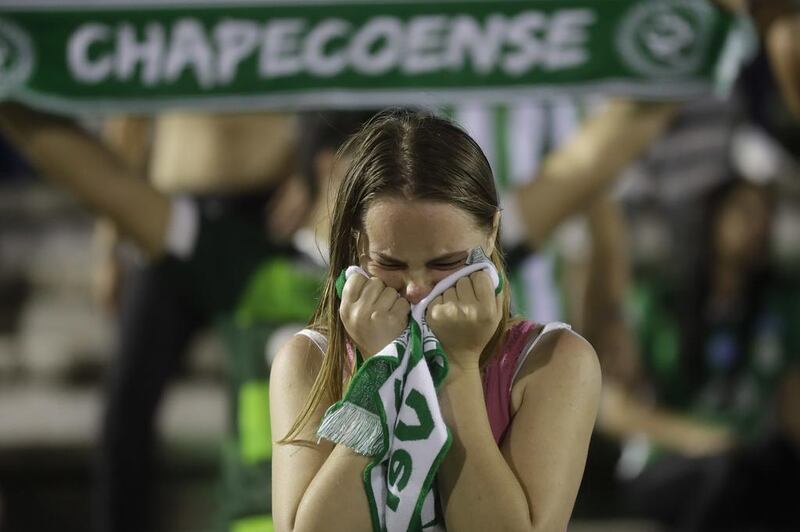LA UNION, COLOMBIA // The plane which crashed in Colombia, killing 71 people including most of Brazil’s Chapecoense football team, may have run out of fuel. Investigators say the chartered British Aerospace 146 was operating at close to the limits of its range.
The distance between Santa Cruz in Bolivia, where the aircraft — a BAE Systems Plc Avro RJ85 — took off, and its destination, Medellin, Colombia, is 1,598 nautical miles. The usual range of that aircraft model is abut 1,600 nautical miles.
“There’s a lot of speculation about the length of the sector,” said Paul Hayes, safety director at London-based aviation consultancy Ascend Worldwide. “It’s very long for an RJ85. You would not normally think of this aircraft as operating that sort of flight on a range basis alone.”
Only six people survived the crash on Monday night — three of them footballers who are unlikely to ever play the sport again.
Goalkeeper Jacson Follmann’s right leg had to be amputated, defender Helio Neto is in intensive care with severe trauma to his skull, lungs and chest and fellow defender Alan Ruschel needed surgery on his spine.
“It’s a miracle,” said his father, Flávio, as he prepared to fly to his son’s bedside in Colombia. “I don’t think I’ll be able to speak, just hug him and cry a lot.”
Four people did not turn up for the flight, including a journalist and two politicians.
“It’s one of those things in life. Only God knows why I ended up staying behind,” said Luciano Buligon, the mayor of Chapeco. Plinio Filho, the head of the club’s advisory council, wept as he recalled the players telling him they were off to “chase a dream” as they left.
“The group was like a family. It was a group of friends, where everyone laughed a lot, even in defeat,” he said.
Footage taken on the plane before take-off showed the young players all laughing together. The same plane was used two weeks ago to fly the Argentine national team with Lionel Messi on board to San Juan, Argentina for a World Cup qualifying match, and Chapecoense coach Mauro Stumpf had said he hoped the plane would “bring (us) luck” like it did when the team flew with the same company to a quarter-final match last month.
Investigators from Brazil, Boliia and the UK joined their Colombian counterparts checking the two black boxes recovered from the crash site near the town of La Union. Among the victims was Chapecoense team manager Caio Junior who had previously coached two UAE football teams, Dubai’s Al Shabab and Abu Dhabi’s Al Jazira.
Initial reports from Colombia on exactly what problems the aircraft encountered remained confused.
Colombia’s El Tiempo newspaper said crews from other flights approaching Medellin airport on Monday night had heard the pilot of the Lamia over the radio, shouting that he was running out of fuel and needed to make an emergency landing.
However, landing priority was given to a plane from airline VivaColombia, which had already reported instrument problems, according to El Tiempo, quoting unidentified sources. Shortly afterward the Lamia pilot carrying the Chapecoense team told the control tower he was experiencing electrical difficulties before the radio went silent.
The other survivors are a journalist and two crew members. The journalist, Rafael Valmorbida, was in intensive care with multiple rib fractures and a partly-collapsed lung. But Bolivian flight technician Erwin Tumiri and stewardess Ximena Suarez escaped serious injury because they followed safety instructions.
“Many passengers got up from their seats and started yelling. I put the bag between my legs and went into the foetal position as recommended,” said Mr Tumiri.
By nightfall on Tuesday, rescuers had recovered most of the bodies which were to be repatriated to Brazil and Bolivia, home of the nine crew members. Investigators returned to the wreckage on Wednesday as soldiers guarded the hillside crash site overnight.
In the event of the RJ85 exhausting fuel supplies, its engines would have stopped running electrical generators, though batteries should have kept critical electronics functioning for some time, said Mr Hayes.
Gustavo Vargas, a director of Lamia, told local media he didn’t think the tragedy was caused by a miscalculation of the fuel needed for the flight, adding that the pilot was experienced and would have diverted to Bogota in the event of a problem.
According to Ascend Worldwide, both the RJ85 and its precursor, the BAe146, have a good safety record. Even local residents accustomed to planes flying at all hours said this crash was especially disturbing.
“It came over my house, but there was no noise, the engine must have gone,” said strawberry-farmer Nancy Munoz, 35.
The city of Chapeco, the home of Chapecoense football team in remote southern Brazil, was plunged into deep mourning. Schools and businesses stayed closed and black, green and white ribbons — green and white are the team’s colours — were draped over fences, balconies and restaurant tables. Black banners hung from the cathedral in the city centre and more were wrapped around a 14-metre statue of one of the town’s founders.
Outside the team’s Conda stadium a group of hardcore fans put up a tent and promised to keep vigil until the bodies of their idols returned to the city.
“We were there for them in victory and we’re here for them in tragedy, rain or shine. Like family,” said Chapecoense fan Caua Regis.
Almost all of the 67 bodies recovered from the crash have been identified, according to a member of the Chapecoense board. The club is planning an open wake at their stadium before Saturday.
On Wednesday, Atletico Nacional of Medellin — the team Chapecoense was due to play in the final of the Copa Sudamericana — requested that the tournament cup be awarded to their Brazilian fellows in honour of the dead.
* Reuters and Bloomberg





